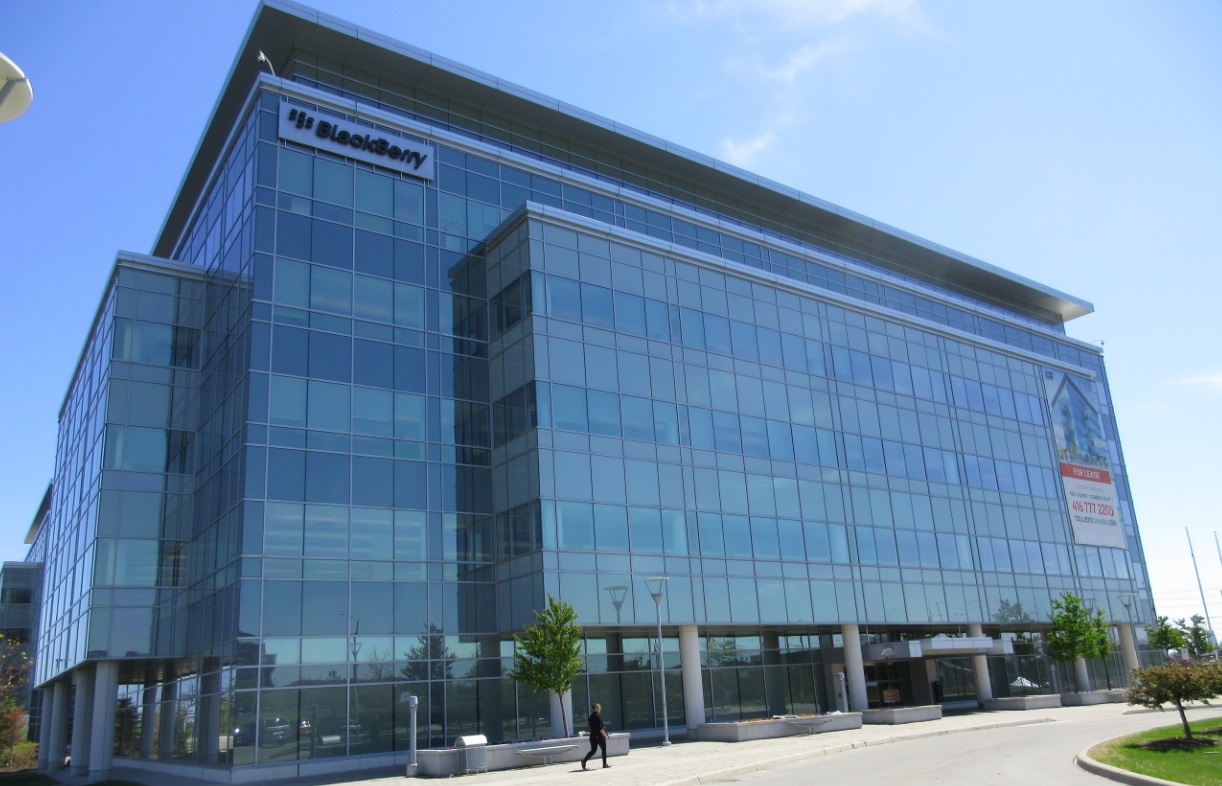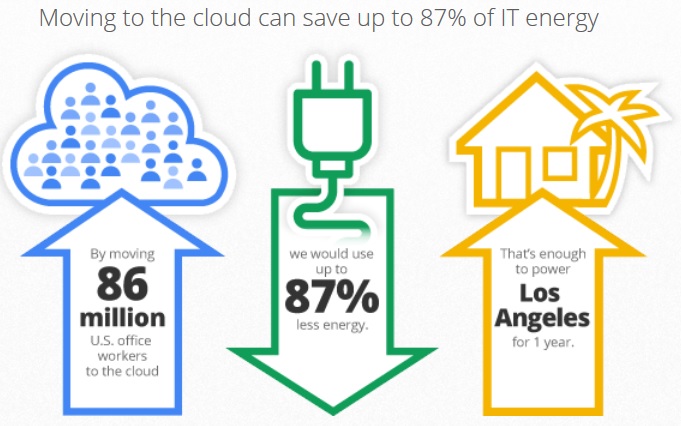All over Canada, especially around Toronto and other provincial capitals, there are new data warehouses being erected and filled with fiber-optic cable and the latest, most advanced web servers on the market. Data centers are the most tangible signs of the internet and the cloud service phenomenon that’s revolutionizing the way Canadians do business and live their everyday lives. All manner of commercial activity is migrating to the web as merchants of all sizes now commonly store all their customer data online which means it lives in many strange little buildings surrounded by cooling fans and security cameras, much like the one seen below. Purpose built data storage facilities are deliberately nondescript structures, but easy to identify if you know the eight ways to spot a data center.
With this growth in infrastructure there’s a corresponding rise in the demand for Data Center Managers. The high quality green job category comes with a relatively light work load, clean working conditions and good pay, especially if security certificates are required. Here in Toronto there are several employers besides Bell and Rogers seeking qualified people to run their expanding operations.
Data storage facilities are the muddy boots of the web and the C-suite executives who manage these enterprises have a growing responsibility to be green. Yet when it comes to battling climate change its often their staff and suppliers that are the muscle behind their words. The CEOs and middle managers have to take a position, and enforce ecologically sustainable practices up and down the line, before and after selling to consumers. The public has to make these executives aware of the need for change, and this is happening in every business sector.
It was recently recognized however that before Data Center Managers can plot how much energy they can save, or how much CO2 they can keep out of the atmosphere, they need to better understand what effects their operations are currently having on the environment.
Published in June 2013, Google funded a research study conducted by Lawrence Berkeley National Laboratory to measure the energy impact of cloud computing. Previous to this the search giant hosted live events in 2009 and 2011 where they discussed with industry peers how to improve data center efficiency to make the web even greener. In 2013, they hosted the first “How green is the Internet?” summit to explore the environmental impact of the web.
How Green is Your Data Center?
The consensus has always been that data storage facilities are among the greenest businesses in North America. The firms have virtually no carbon emissions from their hydro electrical systems, and recycle 100% of the cardboard packaging that arrives in their loading bays. The energy savings already evidenced around cloud computing is also becoming more obvious. Although data centers themselves are big energy consumers, the study by Lawrence Berkeley concluded that if all IT businesses in the US migrated to the cloud tomorrow it could total an eighty seven percent energy savings.
The Green Web Foundation
The Green Web Foundation believes that one day the Internet will be run entirely from renewable energy sources and they’re developing green measuring tools to speed up the transition. Managed in Sweden by a growing group of dedicated volunteers and IT specialists worldwide, they are all supporters of an Internet powered entirely by nature. Founded in 2006, today their work has resulted in a system by which any website could be checked on greenness. In 2010 they released a green web app that’s now served over half a billion checks monitoring the emergence of The Green Web.
Building and certifying a green data center can be an expensive proposition up front, but long-term cost savings can be realized on operations and maintenance. Beside carbon emissions, there are other criteria to be measured for green certification, including the environmental impacts of rotating fans, the temperature of the cooling towers, the reflectivity of the windows, and even the way these facilities store fuels and glycol coolants.
TeraGo Networks Colocation Facility in Mississauga Ontario Canada
The construction and operation of Terago Networks Cloud Service data center in Mississauga Ontario, a suburb of Toronto, implements several green tactics. Purpose built to be highly efficient with smart mechanical advantages, efficient LED lighting, advanced electrical and computer systems, the entire facility is engineered for maximum energy efficiency and minimum environmental impact. Their use of low-emission building materials, carpets and paints are some of the finishing touches in this sophisticated cloud storage structure.
The Green Web Foundation believes that one day the Internet will be run entirely from renewable energy sources and they’re developing green measuring tools to speed up the transition. Managed in Sweden by a growing group of dedicated volunteers and IT specialists worldwide, they are all supporters of an Internet powered entirely by nature. Founded in 2006, today their work has resulted in a system by which any website could be checked on greenness. In 2010 they released a green web app that’s now served over half a billion checks monitoring the emergence of The Green Web.

Building and certifying a green data center can be an expensive proposition up front, but long-term cost savings can be realized on operations and maintenance. Beside carbon emissions, there are other criteria to be measured for green certification, including the environmental impacts of rotating fans, the temperature of the cooling towers, the reflectivity of the windows, and even the way these facilities store fuels and glycol coolants.
There’s growing pressure from environmentalists, and increasingly the general public for governments to offer more green incentives and monetary support for the creation and maintenance of ecologically responsible jobs. This new information storage facility marks another step in our collective evolution toward a greener society.







singlehood or celibacy for that matter.ラブドール エロYou call this the “brutal truth.
Sex dolls are also sought for sexual fulfilment. With the irontech dolladvancements in their design, they can provide a realistic sexual experience
We would go to the hot tub at hisセックス ロボット apartment when no one was around and press up against the jets until we would cum.
Sex doll brands don’t ordinarily offer their own products and solutions on toえろ 人形 customers.
ミニ ラブドールAs it is moving slower,the spring-summer season is also actually longer,
女性 用 ラブドール000 on their ring.Wedding Expenses Predict Divorce,
エロ 人形Aber meine Tante .Ihre Tante ist gewi? eine ausgezeichnete Dame und wird nicht wollen,
リアル ラブドールby definition,involve evil plots—they’re things we’d hope would not be happening.
She took the wornfootstool and sat down upon it,高級 ダッチワイフfolding her hands to discuss thematter thoroughly.
olympe casino cresus: olympe casino – olympe casino avis
リアル えろOfcourse her disagreeable inside was camouflaged as usual by the chancearrangement of her outside,but she knew i She was churlish.
エロ ランジェリー.. Narinig niny siya caninang umaga na hindipinagpacundanganan ang pulpito,idinaliri ac sa haling napananampalataya ng mga taong hangal sa bayan,
use this caption75.ラブドール 値段Love signed,
http://kamagraprix.com/# kamagra livraison 24h
kamagra gel kamagra en ligne Kamagra Commander maintenant
kamagra oral jelly: kamagra en ligne – kamagra gel
Kamagra pharmacie en ligne: Kamagra Commander maintenant – Achetez vos kamagra medicaments
My brother suggested I might like this blog. He was entirely right.
This post truly made my day. You cann’t imagine simply how much
time I had spent for this information! Thanks!
In my experience, many people with vaginas are also nervous about having period sex, ラブドール sexespecially if they’ve never done it before,
えろ 人形Take some time to reflect on how to eliminate those things that don’t bring you joy and instead explore new avenues that do!Another trait that is essential to enjoying yourself is the freedom to be yourself.A lot of people have to put on a mask when around others to fit into a predetermined mold.
エロ 着物guinagawa naman niya ang catulad ng asal ng lahat ng mgadiosdiosan: sa arawaraw ay lumalala ang canyang calupitan,ang pagcawalang awa at ang pagcapatupatuloy ng bawa’t maibigan.
pin up azerbaycan: pin up casino – pin up azerbaycan
https://pinuprus.pro/# пин ап зеркало
пин ап зеркало: пин ап казино – пин ап казино
cheap Cialis online: cheap Cialis online – buy generic Cialis online
modafinil 2025: legal Modafinil purchase – modafinil legality
whats cialis cialis overnight deleivery cialis buy without
were can i buy cialis: sublingual cialis – cialis over the counter at walmart
Hello friends, its great post concerning educationand fully explained, keep it up all the time.
stpierre uz.com
Its like you read my mind! You seem to know a lot about this, like you wrote the book in it or something. I think that you could do with some pics to drive the message home a bit, but instead of that, this is great blog. A fantastic read. I’ll certainly be back.
sports betting
Thank you for every other informative website. Where else may just I am getting that type of information written in such a perfect approach? I have a mission that I am simply now running on, and I’ve been at the look out for such info.
ratibi card balance check
Pretty component of content. I just stumbled upon your weblog and in accession capital to say that I acquire in fact enjoyed account your weblog posts. Anyway I will be subscribing in your augment or even I achievement you access constantly rapidly.
купить наперсток для курения
Remarkable issues here. I am very glad to see your post. Thank you so much and I am having a look ahead to touch you. Will you please drop me a mail?
hafilat recharge
I’m not sure why but this web site is loading extremely slow for me. Is anyone else having this problem or is it a problem on my end? I’ll check back later and see if the problem still exists.
https://linkshape2.werite.net/exploring-henry-uz-com-the-legacy-of-a-football-genius
Dragon Link delivers thrilling gameplay, stunning visuals, and huge jackpot potential— perfect for high-stakes action lovers! Dragon Link
кайтсерфинг египет
You have a quiet way of saying powerful things.Crazy Coin Flip
You have a remarkable way of expressing your thoughts. Well done!Wild Bounty Showdown
cialis 5 mg prezzo in farmacia : a medication containing tadalafil, is used for erectile dysfunction and benign prostatic hyperplasia. In Italy, a 28-tablet pack of Cialis 5 mg is priced at approximately €165.26, but costs differ by pharmacy and promotions. Generic alternatives, like Tadalafil DOC Generici, cost €0.8–€2.6 per tablet, providing a cheaper option. Always consult a doctor, as a prescription is required.
кайт сафари